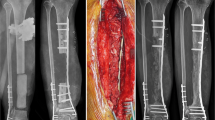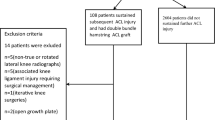Summary
Anterior cruciate ligament (ACL) reconstruction using autologous hamstring tendons are being performed more frequently and satisfactory results have been reported. Advantages such as low donor site morbidity and ease of harvest as well as disadvantages like low initial construct stiffness have been described. Recently, it has been demonstrated that graft fixation close to the original ACL insertion sites increases anterior knee stability and graft isometry. Hamstring tendon fixation techniques using interference screws offer this possibility. To reduce the risk of graft laceration, a round threaded titanium interference screw (RCI) was developed. To improve initial fixation strength, fixation techniques for hamstring tendons with separate or attached tibial bone plugs were introduced. However, data on fixation strength do not yet exist. With respect to the proposed advantages of biodegradable implants, like undistorted magnetic resonance imaging, uncompromised revision surgery and a decreased potential of graft laceration during screw insertion, we performed pullout tests of round threaded biodegradable and round threaded titanium interference screw fixation of semitendinosus (ST) grafts with and without distally attached tibial bone plugs. Data were compared with bone-tendon-bone (BTB) graft fixation using biodegradable and conventional titanium interference screws.
We used 56 proximal calf tibiae to compare maximum pullout force, screw insertion torque, and stiffness of fixation for biodegradable direct ST tendon and bone plug fixation (group I: without bone plug, group II: with bone plug) versus titanium interference screw fixation (group III: without bone plug, group IV: with bone plug). A round threaded biodegradable poly-(D, L-lactide) (Sysorb) and a round threaded titanium interference screw (RCI) were used. As a control calf bone-tendon-bone (BTB) grafts fixed with either poly-(D, L-lactide) (group V) or conventional titanium (group VI) interference screws were used. ST tendons were harvested either with or without their distally attached tibial bone plugs from human cadavers and were folded to a three-stranded graft. Specimen were loaded in a material testing machine with the applied load parallel to the long axis of the bone tunnel.
Maximum pullout force of ST bone plug (group III: 717 N ± 90, group IV: 602 N ± 117) fixation was significantly higher than that of direct tendon (group I: 507 N ± 93, group III: 419 N ± 77) fixation. Maximum pullout force of biodegradable screw ST fixation was higher than that of titanium screw fixation in both settings. There was no significant difference in pullout force between biodegradable (713 N ± 210) and titanium (822 N ± 130) BTB graft fixation or between ST fixation with bone plug and biodegradable screw with BTB fixation.
Pullout force of hamstring tendon interference screw fixation can be improved by using a biodegradable implant. In addition, initial pullout force can be greatly improved by harvesting the hamstring tendon graft with its distally attached tibial bone plug. This may be important, especially in improving tibial graft fixation. This study encourages further research in tendon-bone healing with direct interference screw fixation to confirm the potential of this advanced method.
Zusammenfassung
Die Verwendung von Semitendinosus-gracilis (STG)-Sehnentransplantaten beim Ersatz des vorderen Kreuzbands (VKB) stellt ein anerkanntes Verfahren dar. Vorteile wie eine geringe Transplantatentnahmemorbidität und Nachteile wie eine geringe Verankerungsfestigkeit und -steifigkeit wurden beschrieben. Kürzlich wurde gezeigt, daß eine ursprungsnahe Transplantatverankerung am ehemaligen Ansatz des VKB wesentlich dazu beiträgt, die vordere Kniestabilität und die Transplantat Isometrie zu erhöhen. Die direkte Interferenzschraubenverankerung der STG-Sehnen bietet dafür gute Voraussetzungen. Daten zur initialen Verankerungsfestigkeit liegen jedoch nicht vor. Daher wurde die Verankerungsfestigkeit eines Semitendinosussehnentransplantats, fixiert mit einer rundgewindigen Titan- und einer biodegradierbaren Interferenzschraube, in einem standardisierten Modell untersucht und die gewonnenen Daten mit denen der konventionellen Patellarsehnenverankerung verglichen.
An 56 proximalen Kalbstibiae und humanen Semitendinosussehnen wurde die Ausreißkraft, das Eindrehmoment und die Verankerungssteifigkeit der direkten und der zusätzlichen Knochenblockverankerung eines 3-strängigen Semitendinosussehnentransplantats (STT) untersucht. Die Verankerungsfestigkeit einer biodegradierbaren rundgewindigen Poly (D, L-Laktid)-Interferenzschraube (Sysorb) (ohne Knochenblock: Gruppe I, mit Knochenblock: Gruppe II) und einer rundgewindigen Titanschraube (RCITM) (ohne Knochenblock: Gruppe III, mit Knochenblock: Gruppe IV) wurde verglichen. Als Kontrolle wurde die Verankerungsfestigkeit des Patellarsehnentransplantats (PT), fixiert mit der biodegradierbaren Poly (D, L-Laktid)-Schraube ((Gruppe V) und einer konventionellen Titaninterferenzschraube (Gruppe VI) bestimmt. Die Ausreißkraft des STT mit anhängendem Knochenblock (Gruppe II: 717 ± 90 N, Gruppe IV: 602 ± 117 N) war signifikant höher als bei der direkten (Gruppe I: 507 ± 93 N, Gruppe IV: 419 ± 77 N) Sehnenverankerung. Die Ausreißkraft des STT war jeweils unter Verwendung der biodegradierbaren Schraube signifikant höher. Die biodegradierbare Interferenzschraubenverankerung des STT mit anhängendem Knochenblock war nicht signifikant unterschiedlich zur PT-Verankerung (Gruppe V: 713 ± 210 N, Gruppe VI: 822 ± 130 N). Die Resultate der vorliegenden Untersuchung zeigen, daß die biodegradierbare Interferenzschraubenverankerung des STT der rundgewindigen Titanschraubenverankerung überlegen ist. Die Transplantatentnahme mit anhängendem tibialen Knochenblock kann die Verankerungsfestigkeit erheblich erhöhen und erreicht vergleichbare Werte zur Patellarsehnenverankerung. Diese Ergebnisse zeigen auf, daß biomechanische Nachteile herkömmlicher nicht anatomischer STG-Verankerungstechniken durch die Verwendung von Interferenzschrauben kompensiert werden können.
Similar content being viewed by others
Author information
Authors and Affiliations
Rights and permissions
About this article
Cite this article
Weiler, A., Hoffmann, R., Südkamp, N. et al. Biomechanical evaluation of patellar- and hamstring tendon graft fixation for anterior cruciat ligament reconstruction using a poly-(D, L-lactide) interference screw. Unfallchirurg 102, 115–123 (1999). https://doi.org/10.1007/s001130050382
Published:
Issue Date:
DOI: https://doi.org/10.1007/s001130050382




